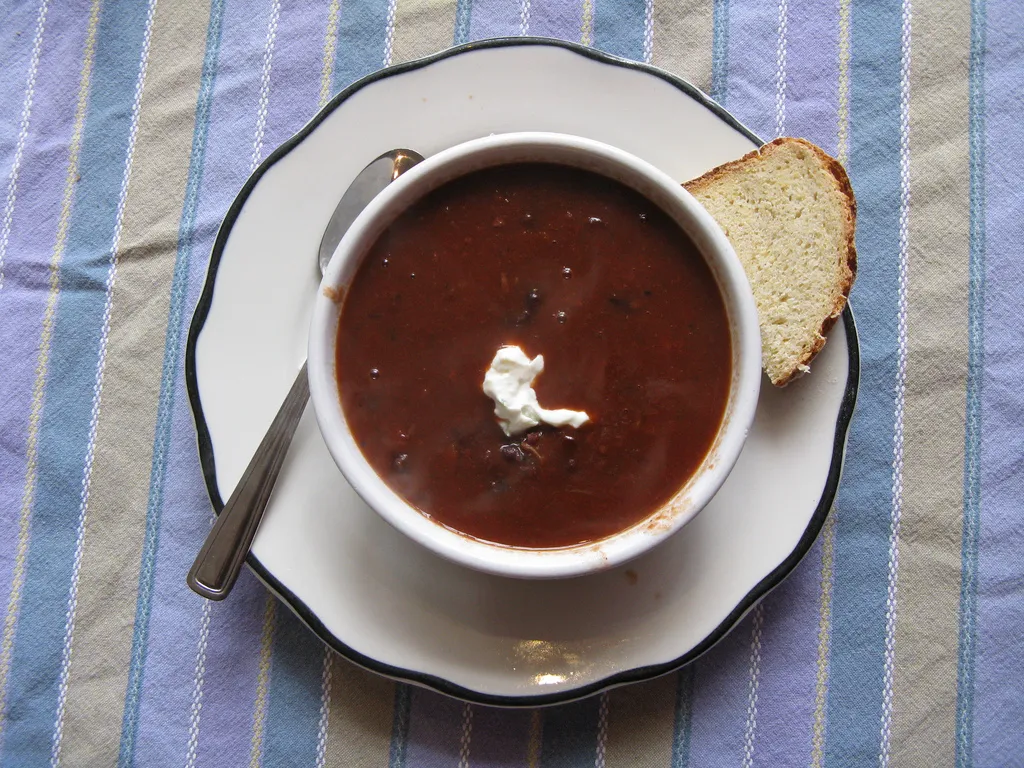The Best Fluffy Pancakes recipe you will fall in love with. Full of tips and tricks to help you make the best pancakes.
Portuguese Bean Soup is a rich, hearty dish that brings together bold flavors, comforting textures, and a deep sense of tradition. Originally introduced to Hawaii by Portuguese immigrants, this soup has become a beloved staple in Hawaiian cuisine, enjoyed by locals and visitors alike. Packed with smoked ham hock, Portuguese sausage, red kidney beans, and a medley of vegetables, it’s the perfect balance of savory, smoky, and slightly sweet flavors.
Whether you’re looking for a warming meal on a chilly day or want to experience a taste of Hawaii from your own kitchen, this authentic Portuguese Bean Soup recipe will not disappoint. It’s easy to make, customizable to your preferences, and even better the next day! Follow along as we break down everything you need to know to prepare this delicious, island-inspired dish at home.
The Origins of Portuguese Bean Soup
A Dish with a Rich History
Portuguese Bean Soup has a fascinating history rooted in immigration, adaptation, and culinary fusion. The dish traces its origins back to Portuguese immigrants who arrived in Hawaii in the late 19th and early 20th centuries, primarily from the Azores and Madeira islands. They came to work on sugarcane plantations, bringing with them their food traditions, including hearty soups and stews that utilized inexpensive yet flavorful ingredients.

One of the key influences from Portuguese cuisine was Caldo Verde, a traditional Portuguese soup made with kale, potatoes, and sausage. Over time, as Portuguese immigrants settled in Hawaii, they adapted their cooking to the ingredients available on the islands, leading to the creation of what is now known as Hawaiian-Style Portuguese Bean Soup.
Why It Became a Hawaiian Favorite
Portuguese Bean Soup quickly became a staple in Hawaiian households, particularly because it was filling, affordable, and easy to make in large batches—perfect for feeding families and communities. Over the years, locals embraced the dish, adding their own touches, such as more vegetables, a tomato-based broth, and an extra helping of smoky Portuguese sausage.
Hawaiian cuisine is known for its unique blend of cultures, and Portuguese Bean Soup is a prime example of how traditional recipes evolve when introduced to new regions. It is now a cherished part of Hawaii’s culinary landscape, often served at gatherings, potlucks, and even local diners and restaurants.
Traditional vs. Modern Versions
While the traditional version of Portuguese Bean Soup includes smoked ham hock, Portuguese sausage, kidney beans, and cabbage, there are now many variations of the dish. Some cooks prefer to make it thicker, almost like a stew, while others add macaroni or rice for a heartier meal. Modern versions may also include different types of beans, extra spices, or even substitutions for a healthier twist.
Despite the variations, the essence of Portuguese Bean Soup remains the same: a deeply comforting, flavorful, and satisfying dish that brings people together. Whether you’re preparing it as a nostalgic family recipe or trying it for the first time, this soup carries with it a history of resilience, adaptation, and the blending of cultures.
Ingredients You’ll Need for the Perfect Bowl
One of the reasons Portuguese Bean Soup is such a beloved dish is the way its ingredients come together to create a rich, smoky, and satisfying flavor. Each ingredient plays a crucial role in balancing taste and texture, making this soup both hearty and comforting. Let’s take a closer look at the key components that make this dish truly special.

1. The Protein Base: Meats That Bring Depth and Smokiness
Portuguese Bean Soup is known for its rich, meaty flavor, which comes from a combination of cured and smoked meats. These proteins infuse the broth with an unmistakable depth that keeps people coming back for more.
- Portuguese Sausage – This is the star ingredient of the dish! Portuguese sausage (or linguiça) is a smoky, slightly spicy, garlicky sausage that gives the soup its signature flavor. If you can’t find traditional Portuguese sausage, Andouille or chorizo can be good substitutes.
- Smoked Ham Hock or Ham Shank – A smoked ham hock adds saltiness and deep umami flavor to the broth as it simmers. It also makes the soup richer by adding a touch of gelatin from the bone, making the texture extra satisfying.
- Bacon (Optional) – Some recipes add crispy bacon bits for an extra layer of smokiness and crunch.
These meats create a savory and slightly spicy base that defines the soup’s taste.
2. The Hearty Vegetables: A Blend of Texture and Flavor
The vegetables in Portuguese Bean Soup add sweetness, crunch, and heartiness, making it a complete meal in a bowl. Here are the must-have vegetables:
- Maui Onion (or Sweet Onion) – Adds a delicate sweetness and depth to balance out the smokiness of the meats.
- Celery and Carrots – These classic soup veggies provide aromatic flavor and natural sweetness, enhancing the overall taste.
- Potatoes – Some versions use diced potatoes to make the soup more filling and comforting. They absorb the flavors beautifully!
- Cabbage – A traditional ingredient that softens as it cooks, adding a mild, slightly sweet flavor and extra nutrients.
- Tomatoes – Many recipes use diced tomatoes or tomato paste to create a flavorful, slightly tangy broth. This adds depth to the soup and enhances its beautiful color.
These vegetables help balance out the richness of the meats and give the soup its signature hearty texture.
3. The Flavor Enhancers: Broth, Beans, and Seasonings
To tie everything together, the soup relies on a bold and well-seasoned broth that allows all the flavors to meld.
- Red Kidney Beans – These are the classic beans used in Portuguese Bean Soup, adding a creamy texture and a protein boost. Some variations also use pinto or white beans.
- Chicken Broth or Beef Broth – The base of the soup, adding depth and richness. You can also use water, but a good broth enhances the flavor significantly.
- Paprika – A key seasoning that gives the soup a smoky, slightly sweet undertone.
- Bay Leaves – Adds an aromatic element that enhances the broth’s complexity.
- Garlic and Black Pepper – Classic seasonings that bring out the soup’s warmth and depth of flavor.
- Salt and Soy Sauce (Optional) – Some modern recipes add soy sauce for umami and extra depth, but traditional versions use salt alone.
These ingredients help create a well-rounded, bold, and comforting soup that is flavorful with every spoonful.
4. Extra Ingredients for Customization
Portuguese Bean Soup is highly adaptable, and you can tweak it to match your preferences. Here are some optional add-ins:
- Macaroni or Rice – Some Hawaiian versions of the soup add macaroni noodles or cooked rice to make it even heartier.
- Crushed Red Pepper or Chili Flakes – If you love a spicy kick, a bit of heat can take the flavor up a notch.
- Corn or Green Beans – Some families like to add extra vegetables for more variety and texture.
Cooking Process: From Simple Ingredients to a Flavorful Soup
Making Portuguese Bean Soup is a rewarding experience, as it allows you to bring together smoky meats, hearty vegetables, and rich flavors into one delicious bowl. While the process is simple, taking the time to prepare and cook each ingredient properly ensures that the soup reaches its full depth of flavor. Follow these step-by-step instructions to make an authentic and satisfying Portuguese Bean Soup at home.
Step 1: Preparing the Ingredients
Before you start cooking, it’s important to get all your ingredients prepped and ready. This will make the cooking process smooth and efficient.
Soak the Beans (If Using Dried Beans) – If you’re using dried kidney beans, soak them overnight in a bowl of water. This helps them cook faster and become tender. If using canned beans, rinse and drain them before adding them to the soup later.
Chop the Vegetables – Dice the onions, carrots, celery, potatoes, and cabbage into bite-sized pieces so they cook evenly.
Slice the Portuguese Sausage – Cut the Portuguese sausage (linguiça or chorizo) into thin slices or small chunks, depending on your preference.
Prepare the Ham Hock (or Alternative Meats) – If using a ham hock, rinse it under cold water to remove excess salt or residue. You can also use ham shank, bacon, or smoked pork if you prefer.
Now that everything is ready, let’s start cooking.
Step 2: Building a Rich and Flavorful Base
The key to a deeply flavorful Portuguese Bean Soup is in how the ingredients are layered and simmered.
Sauté the Portuguese Sausage – In a large pot or Dutch oven, heat a small amount of oil over medium heat. Add the sliced sausage and cook for 3-5 minutes until it starts to brown and release its flavorful oils.
Sear the Ham Hock (If Using) – Add the ham hock or smoked ham to the pot and let it brown slightly. This enhances the smoky, meaty flavor of the broth.
Add the Aromatics – Stir in the chopped onions, garlic, carrots, and celery. Cook for another 5 minutes, stirring occasionally, until the vegetables soften and become fragrant.
Pour in the Broth and Simmer – Add chicken broth or beef broth (or water, if preferred) to the pot, covering the meats and vegetables completely. Throw in bay leaves and paprika for extra depth of flavor. Bring the soup to a boil, then reduce the heat to low and let it simmer for 45 minutes to an hour.
If you want an even richer flavor, simmer the ham hock for an extra hour before adding the remaining ingredients. This will help extract even more flavor from the bones.
To achieve the best results, using the right cookware is essential. A heavy-duty pot or Dutch oven works best for simmering the soup slowly, allowing the flavors to meld together beautifully. If you’re looking for a reliable option, consider this high-quality Dutch oven: Check it out here.
Step 3: Adding the Heart of the Soup
Now it’s time to bring in the hearty ingredients that make this soup so satisfying.
Add the Potatoes and Cabbage – Once the broth has simmered and developed flavor, stir in the diced potatoes and chopped cabbage. These ingredients will soak up the broth and contribute to the soup’s signature texture. Let the soup simmer for another 20-25 minutes until the potatoes are tender.
Stir in the Beans and Tomatoes – Add the kidney beans (cooked or canned) and diced tomatoes to the pot. These will give the soup a thick, hearty consistency. Stir everything together and let it cook for another 10 minutes.
Season to Taste – At this stage, season the soup with salt, black pepper, and any additional spices to your liking. Some people like to add a splash of soy sauce or Worcestershire sauce for extra umami.
Step 4: Adjusting for the Perfect Consistency
Portuguese Bean Soup can be customized to your preferred thickness.
For a Thicker Soup: Let it simmer uncovered for a few extra minutes to reduce the liquid. Some people also mash a few beans or potatoes to naturally thicken the broth.
For a More Brothy Version: Add an extra cup of broth or water if you prefer a thinner consistency.
Adding Macaroni or Rice (Optional): If you’d like a heartier soup, stir in cooked macaroni or rice in the last 5 minutes before serving.
Step 5: Final Touches and Serving Suggestions
Now that your soup is rich, flavorful, and perfectly cooked, it’s time to serve and enjoy.
Remove the Ham Hock – Take out the ham hock and shred the tender meat into bite-sized pieces. Discard the bone and return the meat to the soup.
Garnish and Serve – Serve the soup hot, garnished with fresh parsley or chopped green onions for extra flavor.
Pairing Suggestions: Portuguese Bean Soup is often enjoyed with a side of Hawaiian sweet bread or cornbread for dipping, steamed white rice for a classic Hawaiian-style meal, or a fresh green salad to balance out the richness of the soup.
Enjoy Your Homemade Portuguese Bean Soup
Now that you’ve mastered the cooking process, it’s time to enjoy the warm, smoky, and comforting flavors of Portuguese Bean Soup. Whether you’re making it for a family dinner or meal prepping for the week, this dish is guaranteed to taste even better the next day.
This soup is not just a meal—it’s a dish with history, culture, and deep flavors that will keep you coming back for more. Try out different variations, experiment with seasonings, and make it your own.
Have you tried making Portuguese Bean Soup at home? Share your thoughts, favorite twists, or questions in the comments below.
Serving, Storing, and Reheating Tips
Portuguese Bean Soup is a hearty and flavorful dish best enjoyed fresh, but it also stores and reheats beautifully, making it perfect for meal prep or leftovers. Whether you’re serving it for a family dinner, saving some for later, or warming up a bowl the next day, here’s how to get the best taste and texture every time.
Serving Suggestions
Portuguese Bean Soup is a complete meal on its own, but pairing it with the right sides can elevate the experience.
- Bread Pairings – Serve with crusty bread, Hawaiian sweet rolls, or cornbread to soak up the rich broth.
- Rice on the Side – A scoop of steamed white or brown rice makes the soup even heartier and is a popular way to enjoy it in Hawaii.
- Fresh Garnishes – A sprinkle of chopped green onions, fresh parsley, or even a squeeze of lemon adds a bright contrast to the deep flavors of the soup.
- Accompanying Sides – A fresh green salad, cucumber salad, pickled vegetables, or a simple slaw can provide a refreshing balance to the richness of the soup.
If serving for a crowd, consider offering toppings like shredded cheese, a drizzle of olive oil, or crushed red pepper flakes so everyone can customize their bowl to their liking.
Storing Leftover Portuguese Bean Soup
This soup tastes even better the next day as the flavors continue to develop. Follow these steps to store it properly:
- Refrigerating – Allow the soup to cool completely before transferring it to an airtight container. Store in the refrigerator for up to 4 days.
- Freezing – Portuguese Bean Soup freezes well, making it a great option for batch cooking. Pour cooled soup into freezer-safe containers or heavy-duty freezer bags, leaving some space for expansion. Freeze for up to 3 months.
- Portioning for Convenience – If you plan to freeze the soup, consider portioning it into smaller containers so you can thaw only what you need without having to defrost the entire batch.
Avoid storing the soup with cooked pasta if you’ve added it, as it can become mushy over time. Instead, cook fresh pasta separately and add it to the soup when reheating.
Reheating for the Best Flavor and Texture
Reheating the soup properly ensures it maintains its delicious taste and consistency.
- Stovetop Method (Best Option) – Pour the desired amount of soup into a pot and heat over medium-low, stirring occasionally until warmed through. If the soup has thickened in the fridge, add a splash of broth or water to loosen it up.
- Microwave Method (Quickest Option) – Place a portion of soup in a microwave-safe bowl, cover loosely, and heat in 1-minute intervals, stirring in between, until hot. Be cautious, as thick soups can develop hot spots.
- Slow Cooker or Instant Pot – For large portions, reheat the soup on low in a slow cooker for 1-2 hours or use the “sauté” function on an Instant Pot, stirring occasionally.
If the soup was frozen, thaw it overnight in the refrigerator before reheating. For a quicker option, place the frozen container in a bowl of warm water to loosen the edges before transferring it to a pot for reheating.
Final Tips for Enjoying Leftovers
- Taste the soup before serving and adjust the seasoning if needed, as flavors can mellow over time.
- Add a splash of broth, water, or even a little tomato sauce if the soup has thickened too much.
- If using pasta, cook and add it fresh rather than storing it with the soup to maintain the best texture.
Portuguese Bean Soup is a dish that only gets better with time. With the right storage and reheating techniques, you can enjoy its deep, smoky flavors for days after making it.
Creative Twists to Make It Your Own
Portuguese Bean Soup is already a rich and hearty dish, but one of the best things about it is how customizable it can be. Whether you want to experiment with new flavors, adjust the ingredients to fit dietary preferences, or give it a personal touch, there are many ways to make this classic soup your own.

1. Switch Up the Proteins
The traditional version of Portuguese Bean Soup is made with smoked ham hocks and Portuguese sausage (linguiça or chorizo), but you can get creative with different meats to change the flavor profile.
- Smoked Turkey or Chicken – For a lighter version, swap the ham hock with smoked turkey legs or shredded rotisserie chicken.
- Bacon or Pancetta – Fry some bacon or pancetta at the beginning of cooking to add a deep, smoky taste.
- Beef or Pork Shoulder – Slow-cooked beef or pork can add tenderness and a different meaty richness.
- Vegetarian or Vegan Alternative – Skip the meat altogether and use smoked paprika, liquid smoke, or plant-based sausage to achieve a similar depth of flavor.
2. Experiment with Different Beans
While kidney beans are the standard choice, you can try other beans for a different texture and taste.
- Black Beans – Adds a slightly earthier and creamier texture.
- Chickpeas (Garbanzo Beans) – Gives a nuttier taste and firmer bite.
- White Beans (Cannellini or Great Northern Beans) – Create a smoother and more delicate broth.
- Mixed Beans – Use a combination of beans for added variety and depth.
If using dried beans, be sure to soak them overnight and cook them thoroughly for the best results.
3. Add More Vegetables for Extra Nutrition
The classic version includes cabbage, potatoes, carrots, and celery, but you can add or swap in other vegetables for more flavor and nutrients.
- Bell Peppers – Bring a mild sweetness and vibrant color.
- Zucchini or Squash – Add a light and fresh contrast to the hearty broth.
- Sweet Potatoes – Offer a natural sweetness and extra fiber.
- Spinach or Kale – Stir in leafy greens at the end of cooking for added vitamins.
- Corn or Green Beans – Introduce more texture and a slightly sweet taste.
Adding more vegetables not only enhances the soup’s nutritional value but also makes it more colorful and visually appealing.
4. Try Different Broth and Seasoning Combinations
The broth is the heart of the soup, and small changes can make a big difference in flavor.
- Spice it Up – Add crushed red pepper flakes, cayenne pepper, or a dash of hot sauce for some heat.
- Coconut Milk – Stir in coconut milk for a creamy, slightly sweet variation.
- Herbs and Spices – Experiment with bay leaves, thyme, oregano, or cumin for more complexity.
- Soy Sauce or Worcestershire Sauce – Enhance umami flavor with a splash of these ingredients.
- Wine or Beer – A splash of white wine or a dark beer can deepen the broth’s taste.
For an extra smoky flavor, try adding smoked paprika or a small amount of chipotle powder.
5. Make It Heartier with Different Starches
Portuguese Bean Soup is traditionally served with macaroni or rice, but you can mix things up with other starches.
- Orzo or Ditalini Pasta – These small pasta shapes blend well with the soup.
- Quinoa or Barley – Adds a nutty, chewy texture and extra protein.
- Farro or Bulgur Wheat – Provides a hearty, slightly chewy bite.
- Dumplings – Drop small dumplings into the soup for a comforting twist.
If you prefer a low-carb version, you can skip the pasta or rice altogether and increase the amount of vegetables instead.
6. Regional and Cultural Twists
You can put a global spin on Portuguese Bean Soup by incorporating flavors from different cuisines.
- Hawaiian Style – Add a little pineapple juice or chunks of fresh pineapple for a subtle sweetness.
- Spanish Influence – Use saffron and smoked paprika for a more Mediterranean touch.
- Mexican Fusion – Add black beans, corn, and cumin, and top with avocado or cilantro.
- Asian Twist – Use miso paste or soy sauce to deepen the umami, and finish with green onions and sesame oil.
Each of these variations keeps the comforting essence of the soup while introducing new and exciting flavors.
7. Turn It into a Stew or a Chili
If you prefer a thicker, heartier dish, you can modify Portuguese Bean Soup into a stew or chili-style meal.
- Reduce the Broth – Let the soup simmer uncovered for longer to evaporate excess liquid and concentrate the flavors.
- Mash Some Beans – Use a potato masher to mash some of the beans directly in the pot to create a thicker consistency.
- Add Tomato Paste – Stir in a couple of tablespoons of tomato paste for a richer, more robust texture.
- Use Ground Meat – Replace the ham hock and sausage with ground beef, turkey, or pork for a chili-like variation.
8. Garnish and Finishing Touches
A final topping or garnish can take your soup to the next level.
- Fresh Herbs – Chopped parsley, cilantro, or basil add a fresh contrast.
- Grated Cheese – Sprinkle Parmesan, cheddar, or cotija cheese for a creamy finish.
- Crispy Toppings – Crushed tortilla chips, croutons, or crispy fried onions add crunch.
- A Dollop of Sour Cream or Yogurt – Balances out the richness with a slight tang.
Make It Your Own
Portuguese Bean Soup is a classic dish with deep roots, but that doesn’t mean you can’t put your own spin on it. Whether you stick to tradition or experiment with flavors, this soup is a comforting, satisfying meal that adapts to your preferences. Try different variations and see what works best for your taste—there’s no wrong way to enjoy a bowl of homemade Portuguese Bean Soup.






[…] 🫘 3. How to Make Authentic Portuguese Bean Soup at Home […]